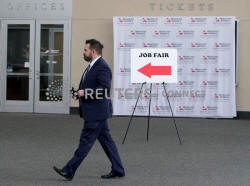U.S. employment growth seen slowing in July; wage gains steady
 Send a link to a friend
Send a link to a friend
 [August 02, 2019] By
Lucia Mutikani [August 02, 2019] By
Lucia Mutikani
WASHINGTON (Reuters) - U.S. job growth likely slowed in July
after outsized gains in the prior month, with wages probably maintaining
their moderate pace of increase, which could boost market expectations
for another interest rate cut from the Federal Reserve next month.
The Labor Department's closely watched monthly employment report on
Friday will come on the heels of Wednesday's decision by the U.S.
central bank to cut its short-term interest rate for the first time
since 2008.
Fed Chairman Jerome Powell described the widely anticipated
25-basis-point cut as insurance against downside risks to the 10-year
old economic expansion, the longest in history, from trade tensions and
slowing global growth. Powell said the move was "not the beginning of a
long series of rate cuts," but also added that he was not saying "it was
just one."
Nonfarm payrolls probably increased by 164,000 jobs last month after
surging 224,000 in June, according to a Reuters survey of economists.
The anticipated job gains would be below the monthly average of 172,000
in the first half.

"If we get a report like we are expecting tomorrow, I don't think it's
going to change anything from the market's perspective of wanting
another rate cut," said Josh Wright, chief economist at iCIMS in New
York. "I don't think it will give the Fed the confidence to push back on
the market."
Financial market expectations for a rate cut in September jumped on
Thursday after President Donald Trump announced an additional 10% tariff
on $300 billion worth of Chinese imports starting Sept. 1 after
negotiators failed to kick start trade talks between the world's two
largest economies.
Fed funds futures implied traders now see a 70% chance the Fed would
lower rates again in September, up from 51% late on Wednesday, CME
Group's FedWatch tool showed.
The U.S.-China trade war is taking a toll on manufacturing, with
production declining for two straight quarters. Business investment has
also been hit, contracting in the second quarter for the first-time in
more than three years and contributing to holding back the economy to a
2.1% annualized growth rate. The economy grew at a 3.1% pace in the
first quarter.
July payrolls would mark a further deceleration in job growth from an
average of 223,000 per month in 2018.
"It remains unclear whether that is due more to moderating demand or to
the increasing difficulty of finding additional workers at the margin,"
said Lou Crandall, chief economist at Wrightson ICAP in Jersey City, New
Jersey.
TIGHTENING LABOR MARKET
Still, the pace of job growth remains well above the roughly 100,000
needed per month to keep up with growth in the working-age population.
The unemployment rate is forecast unchanged at 3.7% in July.
[to top of second column] |

A man walks into register at a job fair in Sandy, Utah, U.S., March
26, 2019. REUTERS/George Frey/File Photo

Despite the lowest jobless rate in nearly 50 years, wage growth has remained
moderate, contributing to a tame inflation environment, which could also lead to
another rate cut next month. Inflation has undershot the Fed's 2% target this
year, rising 1.6% year-on-year in June after gaining 1.5% in May.
Average hourly earnings are forecasting rising 0.2% in July, after a similar
increase in June. That is expected to have kept the annual increase in wages at
3.1% in July for a third straight month. The trend in wage gains has slowed from
late 2018 when wages were rising at their fastest rate in a decade.
Even with the step-down in job and wage gains, the labor market is supporting
the economy, which is slowing as the stimulus from last year's $1.5 trillion tax
cut package fades. Economic growth in the third quarter is seen at around a 1.5%
rate
"The employment report will be a critical element in determining how the third
quarter is starting off," said Sam Bullard, a senior economist at Wells Fargo
Securities in Charlotte, North Carolina. "Extended labor market gains would
support further solid consumer spending growth."
The retreat in job growth in July is expected to have been concentrated in the
goods producing sector of the economy and government, after strong gains in
June, which were not supported by other data.
Manufacturing employment is forecasted rising by 5,000 jobs after accelerating
by 17,000 in June. Factory payrolls could surprise on the downside after a
survey on Thursday showed manufacturing employment hit its lowest level since
November 2016 in July.
The sector, which accounts for more than 12% of the U.S. economy, is being
hobbled by trade tensions, weakening global growth, an inventory bulge -
concentrated in the automotive industry - and design problems at aerospace giant
Boeing Co <BA.N>.

Construction payrolls are also expected to slow after shooting up by 21,000 jobs
in June. A moderation in government employment is anticipated after payrolls
surged by 33,000 jobs in June, the most since August 2018.
The average workweek is seen unchanged at 34.4 hours in July for a fourth
straight month.
(Reporting by Lucia Mutikani; editing by Jonathan Oatis)
[© 2019 Thomson Reuters. All rights
reserved.] Copyright 2019 Reuters. All rights reserved. This material may not be published,
broadcast, rewritten or redistributed.
Thompson Reuters is solely responsible for this content. |